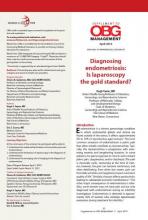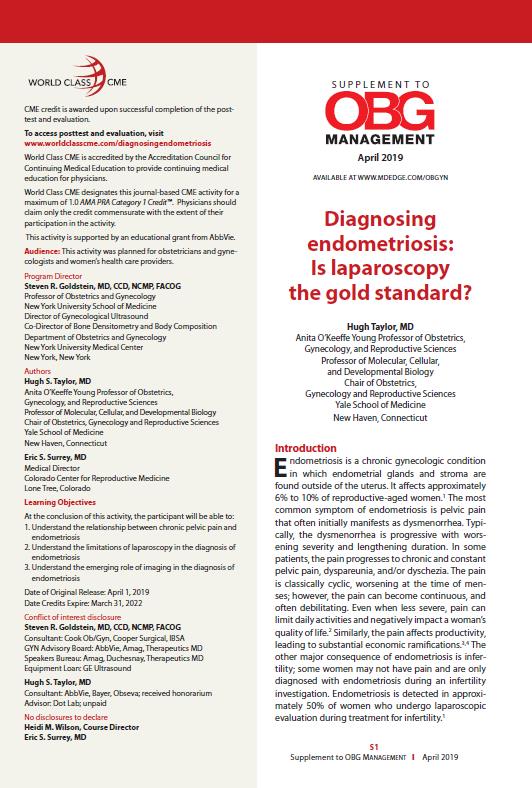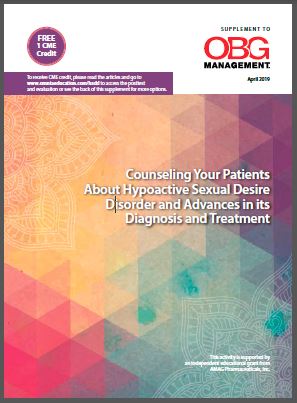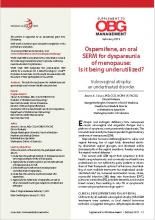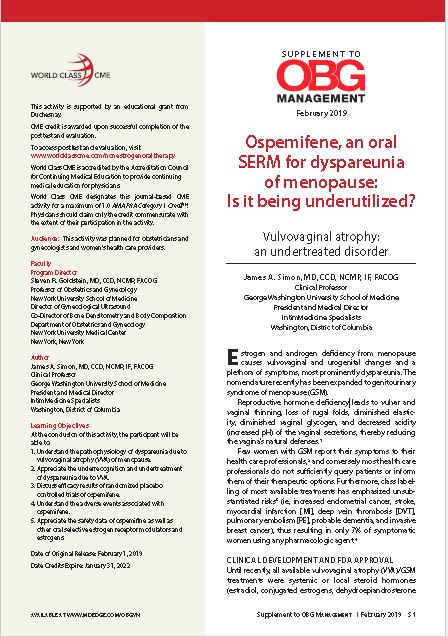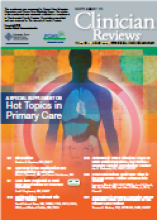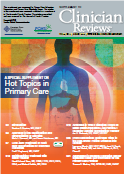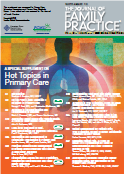User login
Diagnosing endometriosis: Is laparoscopy the gold standard?
This CME supplement to OBG Management provides readers with an understanding of the following topics:
- The relationship between chronic pelvic pain and endometriosis
- The limitations of laparocopy in the diagnosis of endometriosis
- The emerging role of imaging in the diagnosis of endometriosis
Click Here to read the full supplement and access a posttest and evaluation for CME credit.
This CME supplement to OBG Management provides readers with an understanding of the following topics:
- The relationship between chronic pelvic pain and endometriosis
- The limitations of laparocopy in the diagnosis of endometriosis
- The emerging role of imaging in the diagnosis of endometriosis
Click Here to read the full supplement and access a posttest and evaluation for CME credit.
This CME supplement to OBG Management provides readers with an understanding of the following topics:
- The relationship between chronic pelvic pain and endometriosis
- The limitations of laparocopy in the diagnosis of endometriosis
- The emerging role of imaging in the diagnosis of endometriosis
Click Here to read the full supplement and access a posttest and evaluation for CME credit.
Counseling Your Patients About Hypoactive Sexual Desire Disorder and Advances in its Diagnosis and Treatment
For women, sexual health involves both body and mind. Conditions that compromise a woman’s sexual health interfere with intimacy and ultimately impact all areas of her well-being. Hypoactive sexual desire disorder (HSDD) is the most common of the female sexual dysfunctions. HSDD occurs in women of all ages but is continuously underdiagnosed and undermanaged.
The articles in this CME journal supplement comprehensively address the areas of concern that inhibit women’s healthcare clinicians in effectively addressing HSDD—namely patient communications, diagnostic strategies, and therapeutic modalities for treating HSDD. The information presented will allow these healthcare providers to implement strategies that will improve the sexual health of their patients presenting with HSDD, with the intent of improving these patients’ overall sense of well-being.
Click here to read the supplement.
To access the posttest and evaluation and claim credit, visit: www.omniaeducation.com/hsdd
For women, sexual health involves both body and mind. Conditions that compromise a woman’s sexual health interfere with intimacy and ultimately impact all areas of her well-being. Hypoactive sexual desire disorder (HSDD) is the most common of the female sexual dysfunctions. HSDD occurs in women of all ages but is continuously underdiagnosed and undermanaged.
The articles in this CME journal supplement comprehensively address the areas of concern that inhibit women’s healthcare clinicians in effectively addressing HSDD—namely patient communications, diagnostic strategies, and therapeutic modalities for treating HSDD. The information presented will allow these healthcare providers to implement strategies that will improve the sexual health of their patients presenting with HSDD, with the intent of improving these patients’ overall sense of well-being.
Click here to read the supplement.
To access the posttest and evaluation and claim credit, visit: www.omniaeducation.com/hsdd
For women, sexual health involves both body and mind. Conditions that compromise a woman’s sexual health interfere with intimacy and ultimately impact all areas of her well-being. Hypoactive sexual desire disorder (HSDD) is the most common of the female sexual dysfunctions. HSDD occurs in women of all ages but is continuously underdiagnosed and undermanaged.
The articles in this CME journal supplement comprehensively address the areas of concern that inhibit women’s healthcare clinicians in effectively addressing HSDD—namely patient communications, diagnostic strategies, and therapeutic modalities for treating HSDD. The information presented will allow these healthcare providers to implement strategies that will improve the sexual health of their patients presenting with HSDD, with the intent of improving these patients’ overall sense of well-being.
Click here to read the supplement.
To access the posttest and evaluation and claim credit, visit: www.omniaeducation.com/hsdd
Ospemifene, an oral SERM for dyspareunia of menopause: Is it being underutilized?
Estrogen and androgen deficiency from menopause causes vulvovaginal and urogenital changes and a plethora of symptoms, most prominently dyspareunia.
Read the supplement and earn CME credit for your knowledge of the following:
- The pathophysiology of dyspareunia due to vulvovaginal atrophy (VVA) of menopause.
- The underrecognition and undertreatment of dyspareunia due to VVA.
- Efficacy results of randomized placebo controlled trials of ospemifene.
- Adverse events associated with ospemifene.
- Safety data of ospemifine as well as other oral selective estrogen receptor modulators and estrogens.
Click on the image above or here to read the supplement and earn credit
Estrogen and androgen deficiency from menopause causes vulvovaginal and urogenital changes and a plethora of symptoms, most prominently dyspareunia.
Read the supplement and earn CME credit for your knowledge of the following:
- The pathophysiology of dyspareunia due to vulvovaginal atrophy (VVA) of menopause.
- The underrecognition and undertreatment of dyspareunia due to VVA.
- Efficacy results of randomized placebo controlled trials of ospemifene.
- Adverse events associated with ospemifene.
- Safety data of ospemifine as well as other oral selective estrogen receptor modulators and estrogens.
Click on the image above or here to read the supplement and earn credit
Estrogen and androgen deficiency from menopause causes vulvovaginal and urogenital changes and a plethora of symptoms, most prominently dyspareunia.
Read the supplement and earn CME credit for your knowledge of the following:
- The pathophysiology of dyspareunia due to vulvovaginal atrophy (VVA) of menopause.
- The underrecognition and undertreatment of dyspareunia due to VVA.
- Efficacy results of randomized placebo controlled trials of ospemifene.
- Adverse events associated with ospemifene.
- Safety data of ospemifine as well as other oral selective estrogen receptor modulators and estrogens.
Click on the image above or here to read the supplement and earn credit
(CME) Going Flat Out for Glycemic Control: The Role of New Basal Insulins in Patient-Centered T2DM Management
Based on material presented at the 2018 Metabolic & Endocrine Disease Summit (MEDS), this CME supplement to Clinician Reviews provides an overview of evidence and best practices for individualizing and intensifying antihyperglycemic therapy using current basal insulin options to achieve patient-centered goals in individuals with type 2 diabetes mellitus (T2DM). Physician assistants, nurse practitioners and nurses will have the opportunity to complete pre- and post-assessment questions to earn a maximum of 1.5 free CME/CE credits.
Dr. Vanita Aroda and Ms. Davida Kruger walk readers through the following learning objectives:
- Explain the role/usage of ultralong-acting basal insulins for addressing the underlying pathophysiology of T2DM
- Compare ultralong-acting and other basal insulins regarding therapeutic characteristics, including pharmacokinetic/pharmacodynamic profiles, efficacy, safety, and dosing
- Develop patient-centered treatment regimens that include ultralong-acting insulins to minimize barriers to successful use of basal insulin therapy
Based on material presented at the 2018 Metabolic & Endocrine Disease Summit (MEDS), this CME supplement to Clinician Reviews provides an overview of evidence and best practices for individualizing and intensifying antihyperglycemic therapy using current basal insulin options to achieve patient-centered goals in individuals with type 2 diabetes mellitus (T2DM). Physician assistants, nurse practitioners and nurses will have the opportunity to complete pre- and post-assessment questions to earn a maximum of 1.5 free CME/CE credits.
Dr. Vanita Aroda and Ms. Davida Kruger walk readers through the following learning objectives:
- Explain the role/usage of ultralong-acting basal insulins for addressing the underlying pathophysiology of T2DM
- Compare ultralong-acting and other basal insulins regarding therapeutic characteristics, including pharmacokinetic/pharmacodynamic profiles, efficacy, safety, and dosing
- Develop patient-centered treatment regimens that include ultralong-acting insulins to minimize barriers to successful use of basal insulin therapy
Based on material presented at the 2018 Metabolic & Endocrine Disease Summit (MEDS), this CME supplement to Clinician Reviews provides an overview of evidence and best practices for individualizing and intensifying antihyperglycemic therapy using current basal insulin options to achieve patient-centered goals in individuals with type 2 diabetes mellitus (T2DM). Physician assistants, nurse practitioners and nurses will have the opportunity to complete pre- and post-assessment questions to earn a maximum of 1.5 free CME/CE credits.
Dr. Vanita Aroda and Ms. Davida Kruger walk readers through the following learning objectives:
- Explain the role/usage of ultralong-acting basal insulins for addressing the underlying pathophysiology of T2DM
- Compare ultralong-acting and other basal insulins regarding therapeutic characteristics, including pharmacokinetic/pharmacodynamic profiles, efficacy, safety, and dosing
- Develop patient-centered treatment regimens that include ultralong-acting insulins to minimize barriers to successful use of basal insulin therapy
CME: Current Trends in Multiple Myeloma: Customizing Treatment Strategies and Optimizing Outcomes
Click here to read the digital edition of the supplement
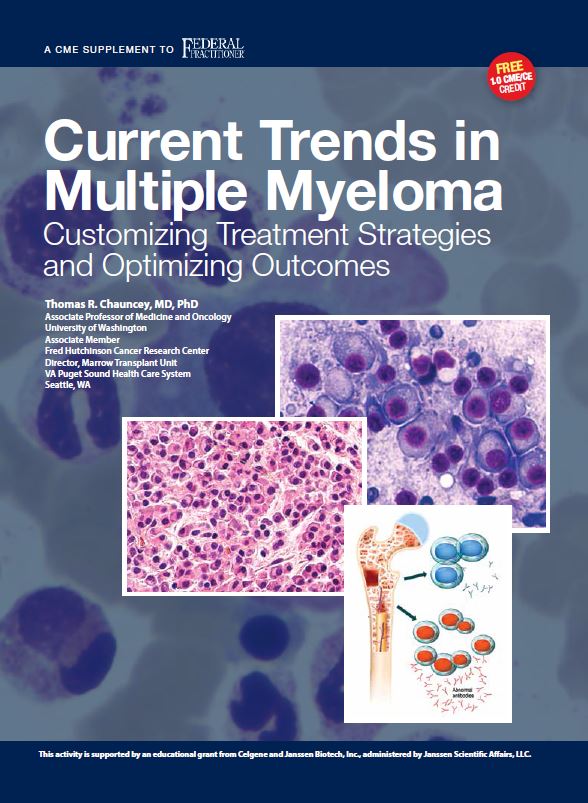
This supplement is supported by an educational education grant from Celgene and Janssen Biotech, Inc.
Topics Include:
- Advances in diagnosis and prognosis
- Management of the newly diagnosed patient
- Treatment advances and current management strategies for relapsed/refractory patients
- Future treatment directions
About the Author
Thomas R. Chauncey, MD, PhD
Associate Professor of Medicine and Oncology
University of Washington
Associate Member
Fred Hutchinson Cancer Research Center
Director, Marrow Transplant Unit
VA Puget Sound Health Care System
Seattle, WA
Click here to read the digital edition of the supplement
Click here to read the digital edition of the supplement

This supplement is supported by an educational education grant from Celgene and Janssen Biotech, Inc.
Topics Include:
- Advances in diagnosis and prognosis
- Management of the newly diagnosed patient
- Treatment advances and current management strategies for relapsed/refractory patients
- Future treatment directions
About the Author
Thomas R. Chauncey, MD, PhD
Associate Professor of Medicine and Oncology
University of Washington
Associate Member
Fred Hutchinson Cancer Research Center
Director, Marrow Transplant Unit
VA Puget Sound Health Care System
Seattle, WA
Click here to read the digital edition of the supplement
Click here to read the digital edition of the supplement

This supplement is supported by an educational education grant from Celgene and Janssen Biotech, Inc.
Topics Include:
- Advances in diagnosis and prognosis
- Management of the newly diagnosed patient
- Treatment advances and current management strategies for relapsed/refractory patients
- Future treatment directions
About the Author
Thomas R. Chauncey, MD, PhD
Associate Professor of Medicine and Oncology
University of Washington
Associate Member
Fred Hutchinson Cancer Research Center
Director, Marrow Transplant Unit
VA Puget Sound Health Care System
Seattle, WA
Click here to read the digital edition of the supplement
Clone of Hot Topics in Primary Care 2018
Click here to read the full supplement.
This supplement offers the opportunity to earn a total of 1.0 CME credits.
Credit is awarded for successful completion of the online evaluations at the link below. This link may also be found within the supplement on the first page of the article.
- Long-term Treatment of Gout: New Opportunities for Improved Outcomes
- To complete the online evaluation and receive 1 CME credit for this article: please click on the link at the end of the article or go to www.pceconsortium.org/gout.
Click here to read the full supplement.
This supplement offers the opportunity to earn a total of 1.0 CME credits.
Credit is awarded for successful completion of the online evaluations at the link below. This link may also be found within the supplement on the first page of the article.
- Long-term Treatment of Gout: New Opportunities for Improved Outcomes
- To complete the online evaluation and receive 1 CME credit for this article: please click on the link at the end of the article or go to www.pceconsortium.org/gout.
Click here to read the full supplement.
This supplement offers the opportunity to earn a total of 1.0 CME credits.
Credit is awarded for successful completion of the online evaluations at the link below. This link may also be found within the supplement on the first page of the article.
- Long-term Treatment of Gout: New Opportunities for Improved Outcomes
- To complete the online evaluation and receive 1 CME credit for this article: please click on the link at the end of the article or go to www.pceconsortium.org/gout.
Hot Topics in Primary Care 2018
Click here to read Hot Topics in Primary Care.
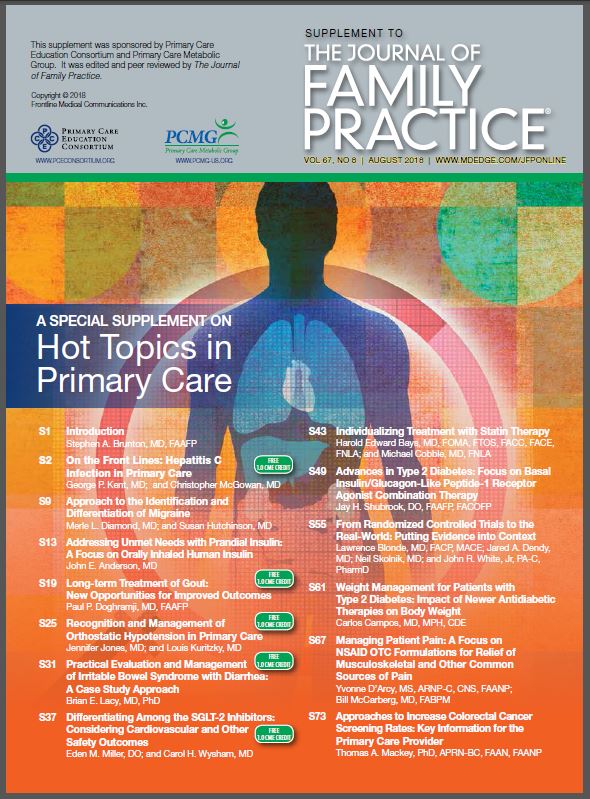
This supplement offers the opportunity to earn a total of 5 CME credits.
Credit is awarded for successful completion of the online evaluations at the links below. These links may also be found within the supplement on the first page of each article.
- On the Front Lines: Hepatitis C Infection in Primary Care
- To complete the online evaluation and receive 1 CME credit for this article: please click on the link at the end of the article or go to www.pceconsortium.org/hepC.
- Long-term Treatment of Gout: New Opportunities for Improved Outcomes
- To complete the online evaluation and receive 1 CME credit for this article: please click on the link at the end of the article or go to www.pceconsortium.org/gout.
- Recognition and Management of Orthostatic Hypotension in Primary Care
- To complete the online evaluation and receive 1 CME credit for this article: please click on the link at the end of the article or go to www.pceconsortium.org/orthostatic.
- Practical Evaluation and Management of Irritable Bowel Syndrome with Diarrhea: A Case Study Approach
- To complete the online evaluation and receive 1 CME credit for this article: please click on the link at the end of the article or go to www.pceconsortium.org/ibs.
- Differentiating Among the SGLT-2 Inhibitors: Considering Cardiovascular and Other Safety Outcomes
- To complete the online evaluation and receive 1 CME credit for this article: please click on the link at the end of the article or go www.pceconsortium.org/sglt2.
Click here to read Hot Topics in Primary Care.

This supplement offers the opportunity to earn a total of 5 CME credits.
Credit is awarded for successful completion of the online evaluations at the links below. These links may also be found within the supplement on the first page of each article.
- On the Front Lines: Hepatitis C Infection in Primary Care
- To complete the online evaluation and receive 1 CME credit for this article: please click on the link at the end of the article or go to www.pceconsortium.org/hepC.
- Long-term Treatment of Gout: New Opportunities for Improved Outcomes
- To complete the online evaluation and receive 1 CME credit for this article: please click on the link at the end of the article or go to www.pceconsortium.org/gout.
- Recognition and Management of Orthostatic Hypotension in Primary Care
- To complete the online evaluation and receive 1 CME credit for this article: please click on the link at the end of the article or go to www.pceconsortium.org/orthostatic.
- Practical Evaluation and Management of Irritable Bowel Syndrome with Diarrhea: A Case Study Approach
- To complete the online evaluation and receive 1 CME credit for this article: please click on the link at the end of the article or go to www.pceconsortium.org/ibs.
- Differentiating Among the SGLT-2 Inhibitors: Considering Cardiovascular and Other Safety Outcomes
- To complete the online evaluation and receive 1 CME credit for this article: please click on the link at the end of the article or go www.pceconsortium.org/sglt2.
Click here to read Hot Topics in Primary Care.

This supplement offers the opportunity to earn a total of 5 CME credits.
Credit is awarded for successful completion of the online evaluations at the links below. These links may also be found within the supplement on the first page of each article.
- On the Front Lines: Hepatitis C Infection in Primary Care
- To complete the online evaluation and receive 1 CME credit for this article: please click on the link at the end of the article or go to www.pceconsortium.org/hepC.
- Long-term Treatment of Gout: New Opportunities for Improved Outcomes
- To complete the online evaluation and receive 1 CME credit for this article: please click on the link at the end of the article or go to www.pceconsortium.org/gout.
- Recognition and Management of Orthostatic Hypotension in Primary Care
- To complete the online evaluation and receive 1 CME credit for this article: please click on the link at the end of the article or go to www.pceconsortium.org/orthostatic.
- Practical Evaluation and Management of Irritable Bowel Syndrome with Diarrhea: A Case Study Approach
- To complete the online evaluation and receive 1 CME credit for this article: please click on the link at the end of the article or go to www.pceconsortium.org/ibs.
- Differentiating Among the SGLT-2 Inhibitors: Considering Cardiovascular and Other Safety Outcomes
- To complete the online evaluation and receive 1 CME credit for this article: please click on the link at the end of the article or go www.pceconsortium.org/sglt2.
Dyspareunia Associated with Vulvovaginal Atrophy: Innovations in Counseling, Diagnosis, and Management
In the United States, there are approximately 64 million women who are postmenopausal. Of these women, it is estimated that 50%—or more than 32 million— have symptoms of vulvovaginal atrophy (VVA) and/or dyspareunia (painful sexual intercourse). These two conditions, along with several others, are components of the Genitourinary Syndrome of Menopause (GSM).
This CME-designated journal supplement is comprised of three articles that provide information and strategies regarding best practices as to patient counseling, diagnosis, and treatment of VVA, and its associated dyspareunia. The goal is to provide women’s health clinicians the knowledge and tools they need to optimize the care they provide to their menopausal patients.
Click here to read the supplement.
https://omniaeducation.com/dyspareunia/
An early version of this supplement distributed at the 2018 American College of Obstetricians and Gynecologists Annual Clinical and Scientific Meetings incorrectly dated the second photo in Figure 9 on page S16 “8-4-2010”. This was later corrected to read “8-4-2011”.
In the United States, there are approximately 64 million women who are postmenopausal. Of these women, it is estimated that 50%—or more than 32 million— have symptoms of vulvovaginal atrophy (VVA) and/or dyspareunia (painful sexual intercourse). These two conditions, along with several others, are components of the Genitourinary Syndrome of Menopause (GSM).
This CME-designated journal supplement is comprised of three articles that provide information and strategies regarding best practices as to patient counseling, diagnosis, and treatment of VVA, and its associated dyspareunia. The goal is to provide women’s health clinicians the knowledge and tools they need to optimize the care they provide to their menopausal patients.
Click here to read the supplement.
https://omniaeducation.com/dyspareunia/
An early version of this supplement distributed at the 2018 American College of Obstetricians and Gynecologists Annual Clinical and Scientific Meetings incorrectly dated the second photo in Figure 9 on page S16 “8-4-2010”. This was later corrected to read “8-4-2011”.
In the United States, there are approximately 64 million women who are postmenopausal. Of these women, it is estimated that 50%—or more than 32 million— have symptoms of vulvovaginal atrophy (VVA) and/or dyspareunia (painful sexual intercourse). These two conditions, along with several others, are components of the Genitourinary Syndrome of Menopause (GSM).
This CME-designated journal supplement is comprised of three articles that provide information and strategies regarding best practices as to patient counseling, diagnosis, and treatment of VVA, and its associated dyspareunia. The goal is to provide women’s health clinicians the knowledge and tools they need to optimize the care they provide to their menopausal patients.
Click here to read the supplement.
https://omniaeducation.com/dyspareunia/
An early version of this supplement distributed at the 2018 American College of Obstetricians and Gynecologists Annual Clinical and Scientific Meetings incorrectly dated the second photo in Figure 9 on page S16 “8-4-2010”. This was later corrected to read “8-4-2011”.
